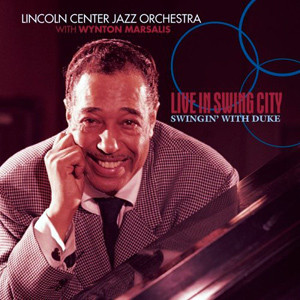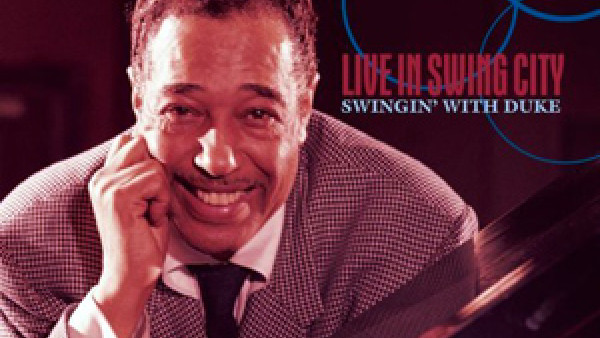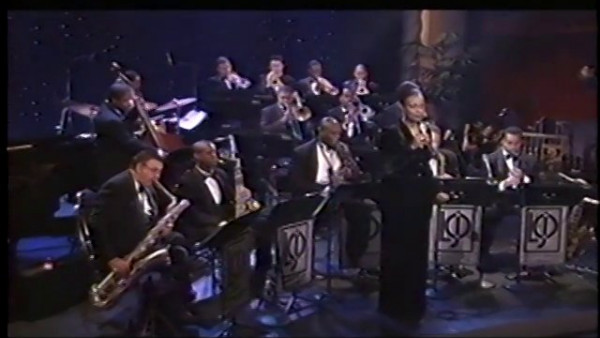A Jazz Success Story with a Tinge of the Blues: At Lincoln Center, Defining the Canon Draws Fire
The scene at the Supper Club on West 47th Street seemed to evoke the glory days of jazz — an ebullient swing band playing classic Ellington tunes as dancers in period costumes rocketed around the dance floor.
But rather than a throwback to the past, the filming for a PBS special was a snapshot of the Lincoln Center Jazz Orchestra as one of the great cultural success stories in New York. In just a decade Jazz at Lincoln Center has become the flagship jazz organization in the United States. Led by Wynton Marsalis, the most celebrated jazz musician of his time, it is scheduled to move to the kind of coveted location that comes along only once every few decades.
Nothing has highlighted the growth of Jazz at Lincoln Center, a constituent of the center for only two years, as much as the announcement in July that the redevelopment plans for Columbus Circle will include an 1,100-seat concert hall and complex of offices and rehearsal rooms for the program. The concert hall is billed as the first to be acoustically designed for jazz.
But the growth of Jazz at Lincoln Center, whose new season is in full swing, is also a reminder of the program’s ambitious agenda and its contentious place in the jazz world.
Jazz at Lincoln Center is not just about making music. It is also, very consciously, about making choices, about defining the canon of an art form that is less than a century old. That goal has almost inevitably brought controversy and with it a question at the heart of the program’s mission: Does it exist mostly to celebrate jazz’s past or should it be helping to shape its future as well?
By almost any conventional measure, Jazz at Lincoln Center has been an astounding success. The program’s budget has grown in three years from $3 million to $9 million, and this year it will present nearly 400 concerts, lectures, classes and workshops in New York and around the world. Most concerts play to sold-out houses. Last year Mr. Marsalis became the first jazz artist to win a Pulitzer Prize for music. On Friday he played and spoke in a program at the White House. Officials are confident they will be able to raise the $65 million it will take to build their new home.
‘‘They’ve done a marvelous job, and incorporating jazz on an equal basis at Lincoln Center is very important,’‘ said Dan Morgenstern, director of the Institute of Jazz Studies at Rutgers University. ‘‘Jazz has never had a space like the one at Columbus Circle. It’s quite wonderful what they’re doing.’‘
But in the jazz world, which often is as factionalized as a lost Trotskyist tribe, the reviews are more mixed.
At the heart of many criticisms is the sense that Jazz at Lincoln Center is using its bully pulpit to foster a cautious, unadventurous view of what jazz is. Given Mr. Marsalis’ celebrity and commercial success, its programming is having an effect beyond Lincoln Center to help determine what kind of jazz and jazz musicians are recorded and promoted.
Some critics and musicians say that the program’s commissions have too often gone to Mr. Marsalis, that he has used his influence to polarize the jazz world and that the program has slighted white artists at the expense of a pointedly Afrocentric view of jazz’s history and traditions.
Most pervasive is the criticism that Lincoln Center is purveying a cautious, static and dated approach to jazz.
‘‘They’ve done a lot to take the essence of jazz and distort it; they’ve put a damper on the main ingredient of jazz, which is innovation,’‘ said George Russell, a much-admired jazz composer and pianist who has been an important figure in jazz since working with Dizzy Gillespie in the 1940’s. ‘‘I think whatever happens at Lincoln Center, history will have to correct it, because it does need correcting terribly.’‘
Rather than just a window onto Jazz at Lincoln Center, the disputes are highlighting two vexing issues in jazz overall.
The first is the generational flip-flop in which most of the innovators are in their 40’s, 50’s and 60’s, while the most conspicuous younger musicians, modeled after Mr. Marsalis, are viewed as polished, cautious traditionalists.
The second is the ill-defined cultural status of jazz, with some skeptics questioning whether it belongs at Lincoln Center and others questioning whether it will inevitably be watered down because it is there.
Mr. Marsalis said the criticisms, which have played out in the jazz press almost since the program began, are old issues recycled too many times.
‘‘Ellington faced this; Coltrane had to defend himself in writing,’‘ he said. ‘‘There’s always some side story that becomes the issue instead of the music. And my whole thing is, What about the music?’‘
The writer Stanley Crouch — who along with Mr. Marsalis, Rob Gibson, who is Jazz at Lincoln Center’s executive producer and director, and the author Albert Murray has helped define the program’s approach — says the criticisms reflect envy more than substance.
‘‘If you’ve got a classic Rolls driving by on a hot day and a guy standing in the sun waiting for a bus, that guy is going to have one of two reactions,’‘ Mr. Crouch said. ‘‘Either the Rolls is no good or he should be driving it. Most of the criticisms come down to either ‘I’m not being hired there,’ or ‘My ideas are not being adopted.’ ‘’
After Just 11 Years, An Equal Partner
Beginning with a three-concert jazz program in 1987, Jazz at Lincoln Center became a department, dependent on Lincoln Center for money in 1991, and in 1996 became the 12th independent constituent on an equal footing — if not with equal resources — with powers like the New York Philharmonic.
‘‘We’ve had astounding growth, and it’s the result of the incredible power of this music,’‘ said Gordon Davis, the program’s chairman, a former city parks commissioner and now a powerful real estate attorney. ‘‘We’re all riding a mission here because we’re involved in something we believe is profoundly important, which is this music, in this country at this time.’‘
The mission translates to acclaimed education programs, particularly those taught by Mr. Marsalis. And the Lincoln Center Jazz Orchestra has the most extensive touring schedule at Lincoln Center, with 90 cities on five continents this year.
The program’s mission also consciously extends to trying to define what jazz is. Mr. Marsalis and Mr. Gibson argue that just as European music has an established canon of essential music, jazz too needs to establish its own canon, with Louis Armstrong, Duke Ellington, Charlie Parker and others as its version of Bach, Mozart and Beethoven.
Many jazz fans, particularly those in the large group more likely to hear jazz at a concert hall than a downtown club, find it hard to fathom what could be wrong with a vibrant jazz presence at the leading American performing arts complex.
‘‘Anyone doing as much as they’re doing to promote the appreciation and respect and love of the music is doing the right thing,’‘ said Richard Cohen, a creative director at a Manhattan advertising agency.
But in the jazz world the picture is far more mixed.
‘‘What they do there sounds so old,’‘ said Sonny Fortune, a saxophonist who has played with Miles Davis and many others. ‘‘I want to get excited by music, but a lot of what they do there, you can go to sleep on it. I don’t know if I’d say absolutely that what they do is bad for jazz, but surely, absolutely I wouldn’t see it as good.’‘
Similarly, many musicians scoff at the notion that it is the role of Lincoln Center to establish a canon for jazz, saying such a canon evolves naturally and that Lincoln Center’s version is pallid and limited.
Others say Lincoln Center’s institutional heft and commercial muscle has distorted the economics of the jazz business.
Other Musicians Find Less Work
Marty Khan, whose company, Outward Visions, has represented jazz artists and promoted jazz concerts and events for more then two decades, said that when he started out, colleges and arts groups used to program 4 to 12 jazz events a year, paying $4,500 to $7,500. Now many just do a few dates, usually including one by Mr. Marsalis or the Lincoln Center Jazz Orchestra at several times that cost. This results in less work for other artists and audiences weaned on classical, mainstream jazz rather than more adventurous fare.
Greg Osby, a saxophonist who has moved between mainstream jazz and more progressive jazz, said the passions about Lincoln Center’s direction have cooled since they were the talk of jazz a few years back, partly because not many musicians outside what he described as ‘‘a select few people who pander to a certain taste and ideology’‘ now expect to play there.
‘‘There’s plenty of resentment, but everyone has come to the conclusion that no matter who gripes, it’s not going to change anything,’‘ he said.
He added that most artists realized that Lincoln Center did not represent all of jazz, just one facet of it, and that venues more partial to experimentation could flourish at the same time. Still, he said, given its visibility and resources, many musicians wish Jazz at Lincoln Center had a broader vision.
‘‘Jazz is a living art form that feeds on contemporary trends, steps across fences, borrows from alien sources and brings them back in a new way,’‘ he said. ‘‘You have people doing incredible things today, but they never get a chance to play at Lincoln Center because they seem to think jazz stopped in 1967.’‘
In a Black Forte, Race Is an Issue
And, in a field where racial issues, including questions about whether whites can play jazz, have been tossed around for decades, it’s not surprising that some white musicians and critics say Lincoln Center in its programming, tributes and commissions has regularly slighted the contributions of white musicians. Of 16 musicians commissioned to create original music cited by Mr. Gibson, 4 four were white, 1 was Latino and the rest were black. The commissions range from $2,500 to $15,000. Mr. Marsalis, whose composing gets more mixed notices than his playing, has been commissioned to do a work every year but one since they began as part of his contract. Mr. Gibson declined to say how much Mr. Marsalis is paid.
Mr. Marsalis and Mr. Gibson dismiss any notion of a racial slant, and others say that almost any fair reading of the giants of jazz would have a preponderance of blacks. And Mr. Gibson said many criticisms reflected the misimpression that Mr. Marsalis’s work is synonymous with Jazz at Lincoln Center.
‘‘I think lots of the people who criticize us have never looked at what we do,’‘ Mr. Gibson said. ‘‘You can’t look at the musicians we’ve featured and say this is a predictable, narrow approach.’‘
Mr. Gibson cited musicians as diverse as Benny Carter, Ray Santos, the Japanese conductor and arranger Katsuhiko Tanaka and Joe Lovano as evidence of the range of works presented at Lincoln Center.
In addition to a broad range of concerts, programming this year includes a yearlong celebration of the centennial of Duke Ellington’s birth and collaborations with the New York Philharmonic and New York City Ballet.
Mr. Marsalis said he makes no apologies for making esthetic judgments of what musicians to feature, decisions that have largely tuned out both avant-gardists on one side and purveyors of pop jazz or electric funk on the other.
He said the focus on a jazz canon is not a static approach to jazz but a way of establishing a bedrock of excellence that all great players need to master before they can develop fully on their own.
‘‘If you’re a writer, it’s assumed that you should know Shakespeare or Melville or Dickens,’‘ Mr. Marsalis said. ‘‘But in our field, for some reason, you had people saying to be great in jazz you’re not supposed to know anything. That’s the view that was prevalent when I was coming up, and that’s what’s helped to deplete our field of musicians.’‘
Some musicians say the real problem is not what Lincoln Center does or doesn’t do, but that so few others are trying to do the same thing. There are plenty of jazz orchestras, including Jon Faddis’s Carnegie Hall Jazz Band, but no major arts institution has made the commitment that Lincoln Center has to a continuing presence.
‘‘Wynton has to be himself; if Ornette Coleman was heading Jazz at Lincoln Center, it would be very different,’‘ said Joe Lovano, a white saxophonist, who received a Lincoln Center commission for a work. ‘‘What Wynton is doing is great. The trouble is you can’t expect them to do everything. What you’d like to see is for this to springboard across the country, so that every city that has a major symphony orchestra has a jazz orchestra as well.’‘
Even some of the critics say Lincoln Center’s role in many ways mirrors the commercial currents of jazz in general and the constraints of trying to run a nonprofit organization at high-cost venues like Alice Tully Hall. Thus Lester Bowie, a trumpeter and vocal critic of Mr. Marsalis, said he did not expect to play at Lincoln Center because his work is more popular in Europe than in the United States.
Mr. Gibson said much of the backbiting had reflected the inevitable growing pains of a program starting with the most essential music and slowly making its way through the rich panoply of the jazz world.
New Solutions In a New Home
He said the new hall would allow Jazz at Lincoln Center to present 5 to 10 times as much jazz in New York as the organization has been able to do in the past, some of it in smaller or less expensive spaces that will be more conducive to commercially marginal fare.
‘‘There are a lot more musicians and a lot more of the jazz community we want to put on our stage,’‘ he said. ‘‘I mean we’re just getting to Hank Jones. This is one of the most important jazz musicians of our time. He’s 80 years old, and we’ve never had him on our stage. We’re not trying to be politically correct. It just takes time to get to everyone we’d like to have. People forget that we’re a very young organization in a very young art form. We’re at the mezzanine level of a 20-story building.’‘
by Peter Applebome
Source: New York Times



